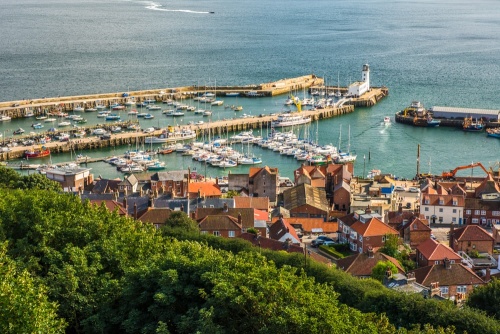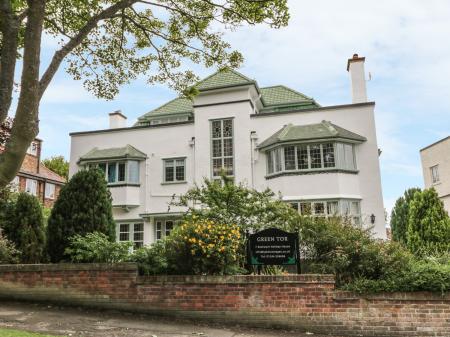
History
A Roman signal station was established on the cliffs here in the 4th century, but the town itself was founded by the Viking Thorgils Skarthi around 966 AD.
Scarborough Fair, commemorated in the popular song of the same name, was held annually from the 13th to the 18th century. In 1253 Henry II granted the first royal charter allowing Scarborough to hold an annual fair. What made this particular fair so important was its length; Scarborough Fair lasted 45 days, from 15 August-29 September by modern reckoning.
The size and length of the fair brought traders from all over Britain and from places as far afield as the Byzantine Empire and the Baltic States. The fair was at its height until the late 14th century and eventually ceased in 1788. A much smaller, shorter celebration usually takes place each September, but it's not a patch on the medieval Scarborough Fair!

Scarborough Spa
Scarborough can make a fair claim to being the world's first seaside resort. The discovery of mineral springs here in 1626 led to Scarborough's growth as a popular destination for a bit of "R&R" as people came to enjoy the supposed health-giving benefits of the mineral-rich waters. Long before 'taking the waters' became popular in Bath and Brighton visitors were flocking to Scarborough to enjoy the mineral springs and the lure of the seaside.
The number of visitors enjoying the waters here makes it no surprise that the first bathing machines were employed at Scarborough, enabling bathers to enjoy bathing in modest comfort. The popularity of Scarborough as a seaside destination led to new purpose-built hotels, such as the Crown and The Grand.
There are 2 main beaches, each with a distinct character. North Bay is quieter, with a nostalgic feel, while South Bay is a bustling place, bustling with people and a profusion of amusement arcades and ice-cream stalls. North Bay Miniature Railway is one of the oldest miniature railways in the country and takes visitors from Peasholm Park to Scalby Mills.

Scarborough Castle
Long before the coming of the Romans, the cliffs at Scarborough were used as a natural fortress by Iron Age peoples. Pottery finds suggest the site was used as early as 2100 BC, but not permanently settled until 800 BC. The Romans built a timber signal station in the late 4th century, then around AD 1000 a Saxon chapel was built within the Roman fort.
In 1138 William le Gros, Earl of York, built a wall across the headland and began a new stone fortification. A settlement grew up outside the castle, and this settlement expanded and grew into the modern town of Scarborough. The castle was strengthened by a succession of kings, including Henry II and King John, and was a major royal stronghold in the north for centuries.
The castle was held by both sides in the Civil War, and would have been sighted by Parliament had the townsfolk not objected. The castle was used as a military garrison and prison until 1920 when it was restored and placed into the care of English Heritage.

The Rotunda Museum
The Rotunda Museum, more properly known as the William Smith Museum of Geology, is the second oldest purpose-built museum in England. It was constructed in 1829 by William Smith, a prominent geologist, and houses local finds of geology and archaeology, plus an exhibit on the heritage of the Scarborough area.
The range of exhibits is remarkable and includes finds from the Stone Age site at Star Carr and dinosaur fossils from the Yorkshire coast. Perhaps the most popular exhibit is Gristhorpe Man, a Bronze Age skeleton found buried in a coffin made from a hollowed-out tree. You can see the skeleton and the well-preserved remains of the coffin in a special display case.

Scarborough Art Gallery
A short walk from The Rotunda brings you to the Scarborough Art Gallery, housed in a lovely 19th-century Italianate villa known as Crescent House. The villa was built in 1845 by a solicitor named John Uppleby on one side of Crescent Gardens. The building was purchased by the Borough Council in 1942 and opened as a public art gallery 5 years later.
Within the Gallery is a permanent collection of fine art including works by such famous artists as Frederic, Lord Leighton. Many of the artworks depict views of Scarborough at the height of its fashionable spa popularity. When our family visited there was a fascinating display of railway posters promoting the Scarborough area to potential visitors.
Maritime Heritage Centre
Near the bustle of South Bay is the Maritime Heritage Centre, which crams a wealth of information about Scarborough's long seafaring heritage into a small space. The Museum maintains extensive records and is a great resource for researchers. One delightful exhibit looks at the history of traditional knitted garments made for sailors including the 'Scarborough' pattern gansey, or knitted jumper.
St Mary's Church
A short walk uphill from the Maritime Heritage Centre brings you to St Mary's Church, begun in the 12th century. The church was originally much larger but it was heavily damaged in the Civil War. The interiors boast a wealth of 18th-19th century wall monuments.

Anne Bronte's Grave
In the large churchyard is the grave of Anne Bronte, author of the novels Agnes Grey and The Tenant of Wildfell Hall. Bronte died in 1849 while at the Grand Hotel in Scarborough where she had come hoping that the sea air would help her recovery from consumption (tuberculosis). Her sister Charlotte Bronte decided to bury her in Scarborough rather than at the family home in Haworth, saying she would, 'lay the flower where it had fallen'.
Charlotte commissioned a headstone which contained several incorrect facts. She had the stone refaced, but even the newly carved stone wrongly gives Anne's age at the time of her death as 28, when, in fact, she was 29 years old. You can see the original gravestone beside a later plaque placed in 2011 by the Bronte Society.
A bit further afield is the popular vintage North York Moors Railway, linking Whitby with Pickering, and taking in some of the best scenery in the North York Moors National Park.









 We've 'tagged' this attraction information to help you find related historic attractions and learn more about major time periods mentioned.
We've 'tagged' this attraction information to help you find related historic attractions and learn more about major time periods mentioned.





